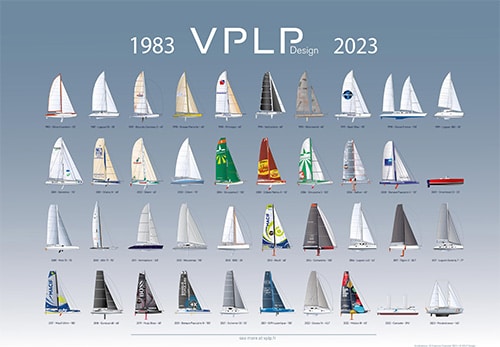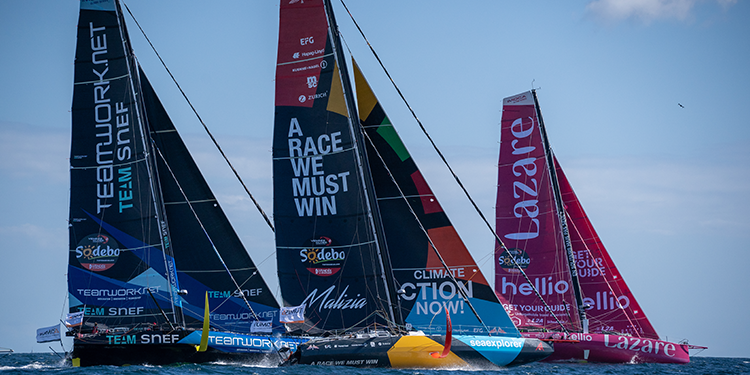How about giving the superyachts that regularly compete in Mediterranean regattas – and whose owners cross the Atlantic in early winter to take part in the best Caribbean events – the chance to benefit from the design innovations generated by the offshore racing circuit? Inspired by this exciting premise, VPLP Design developed a concept called Paragon, an 85-footer which offers unparalleled performance thanks to a canting keel and foils. Partner Naval Architect Quentin Lucet and designer Yann Prummel present the concept.
Images filmed in Porto Cervo last autumn of the 60’ Flying Nikka overtaking Tango, a Wally Cento one and a half times her size, went viral on the web and social media. Six months later Malizia, Boris Herrmann’s 60’ IMOCA designed by VPLP, added 23 nautical miles to the 24 Hour Distance Record held since 2015 by Comanche (100’) – also designed by our firm, in collaboration with Guillaume Verdier. The record now stands at 641.13 nautical miles for an average speed of 26.71 knots. “Another big indication that a paradigm shift in boat design could be occurring,” says Quentin Lucet. “Previously, bigger meant faster. Today, foils are rewriting the rules.”
This observation encouraged VPLP Design to conceptualize Paragon, an 85’ yacht featuring a canting keel and foils. Designed for racing round three buoys and participating in major IRC events (Middle Sea Race, Caribbean 600, etc.), this monohull leverages her foils to make herself lighter and faster, judiciously exploiting the skimming effect rather than achieving true hydrofoiling. Digital simulations undertaken by VPLP Design and routings on courses similar to the Middle Sea Race and the Giraglia all point to the conclusion that an 85’ foiler can beat a 100-footer of conventional design. “Compared to a boat of the same size with a fixed keel,” says Quentin Lucet, “an 85-footer with a canting keel and foils carries three tonnes less lead in the bulb and weighs only twenty tonnes.”
In Pursuit of Perfection
These figures can also be compared to the fifty tonnes of a 100’ maxi which requires more than twenty crew to handle her in a race. Reductions in weight and stresses across the board suggest that it will be possible to sail with crews half the size of those required on the maxis currently in circulation. “Especially since the foils are much easier to handle than on an IMOCA, for example,” says the architect. You set them as soon as you hit 10 knots of true wind, and bring them in when you’re alongside. They don’t increase the ship’s beam.”
Not only does Paragon’s architecture disrupt the well-established trends of the yachting world, her style does too. It’s a consideration that appears early on in the general process. “Like the start of any project we undertake, the first thing we do is define the concept to find the vessel’s soul and personality,” says Yann Prummel, designer at VPLP since 2020. “Much of the creative process involves us immersing ourselves in the context surrounding the project. We educate ourselves on the latest innovations and trends, and identify the aspirations of our customers long before putting pencil to paper on the drawing board. Style isn’t just about aesthetics, its purpose is also to resolve problems and make an object such as Paragon unique, flawless and efficient, while satisfying the expectations of our customers.”
On this project, the team took inspiration from the art of jewellery-making to create a mineral-like minimalist concept. “Paragon” is also the name of a flawless diamond mined in Brazil. The deck and superstructures were meticulously refined to remove the superfluous, allowing us to focus on visual perfection and the sailing experience. “The coachroof doesn’t rise out of the deck. It’s as if, by merging, they produce a faceted and perfectly integrated object,” says the designer. Their fastidious work emphasizes the vast teak deck not only as a space for relaxing but also as the theatre of sailing operations. And the deck also benefits from the presence of the foils. “The faster the boat sails, the more the foil lifts and puts the boat on a level plane,” says Quentin Lucet. “It completely changes the relationship between the crew and the extremely beamy deck, the latter synonymous of the lifestyle aboard these racing yachts.”






